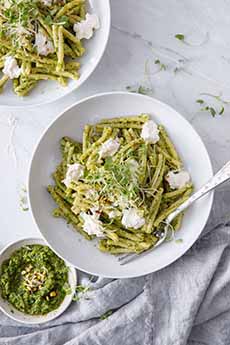Cumin-Spiced Pistachio Pesto Recipe For National Pistachio Day
|
Here’s another recipe for National Pistachio Day 2023: a cumin-spiced pistachio pesto recipe that is delicious on: > The history of pistachio nuts. This recipe adds a Middle Eastern spin to pesto, from the pistachio nuts to the cumin (see more about cumin below). Unlike Italian pesto, this recipe has no cheese; the recipe is vegan. The recipe makes enough for 2-3 pounds of chicken or fish. Prep time is 15 minutes. Thanks to Pereg Gourmet for the recipe. 1. ADD the pistachios to a food processor and pulse at high speed. Add the lime zest and juice and process at high speed. 2. ADD the rest of the ingredients. For the parsley, twist the bunch with your hands, separating the leaves and small stems from the long bottom stems. Discard the bottoms. 3. MIX on low speed or pulse, stopping to push down the mixture. Once all the ingredients are incorporated… 4. BLEND at high speed until a uniform puréed consistency is achieved. This should take around 15-30 seconds. For a smoother texture, blend for up to 1 minute. 5. TASTE and just the seasoning accordingly, adding more salt or lime juice as desired. Refrigerate, covered, until ready to use. 1. PREHEAT the oven to 425°F. On a parchment-lined tray, place the salmon, skin-side down, and pat dry. Spread the pesto generously over the fish. Bake uncovered for 20-25 minutes (baking time will vary depending on the thickness of the fish.) If you’d like some heat, blend 1/2 a jalapeño chile into the pesto mix and drizzle on scrambled eggs. For a refreshing take on sunnyside-up eggs, add the pesto to the hot skillet before adding the eggs. Cumin is the dried seed of the herb Cuminum cyminum, a member of the parsley family (Apiaceae). It originated in the Iranian plateau. Cumin seeds are easily confused visually with caraway seeds, another spice in the parsley family. Many Slavic and Uralic languages refer to cumin as “Roman caraway” or “spice caraway.” The distantly related Bunium persicum and Bunium bulbocastanum and the unrelated Nigella sativa are both sometimes called black cumin [source]. |
|
|
|
Cumin has been used as a spice for thousands of years. Seeds of wild cumin excavated in the settlement of Atlit-Yam were dated to the early 6th-millennium B.C.E. Cumin was a significant spice for the Minoans in ancient Crete. The ancient Greeks kept cumin at the dining table in its own container (much as pepper is frequently kept today), a practice that continues in Morocco. Cumin was also used heavily in ancient Roman cuisine and in India. Cumin was introduced to the Americas by Spanish and Portuguese colonists. And some spice trivia: Cumin is often used as part of bird food mixes [source]. According to McCormick, cumin is one of the top 10 spices sold in the U.S. In fact, cumin is the second-most-sold spice in the world, just behind black pepper [source]. Cumin has a distinctive flavor and aroma: earthy, nutty, piquant, tangy, and warming. CHECK OUT WHAT’S HAPPENING ON OUR HOME PAGE, THENIBBLE.COM. |
||






